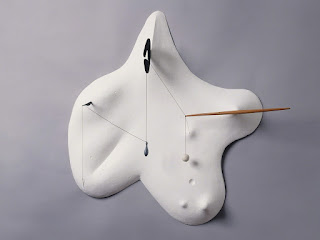VII: Thomas Crow on Robert Rauschenberg
 |
| Minutiae 1954 by Robert Rauschenberg |
One of the artists I like quite a bit is Robert Rauschenberg but it’s always been hard for me to express why. His work is appealing, confusing, sometimes overwhelming, and frustrating all at the same time. Is it, as author Thomas Crow has noted has been said about his work, merely “a dumping ground?” This essay sheds some light as to ways to understand, not interpret, Rauschenberg’s work, but runs into dead ends and false starts more often than not. That being said, here are some things I felt were useful.
To start, build a foundation of what Rauschenberg was getting at via his method. Found objects. Readymades. Collage. The flotsam and conventions of contemporary society. Coded language. Abstraction. Figurative iconography. But after that it’s a deep plunge off the cliff, just like the frequent allusion he made to cartoons from the 1950s where people regularly plunged off of cliffs but were buoyed by large umbrellas that deposited them more or less safely on the ground, but not until after having had a terrifying experience.
I found an unlikely umbrella in the form of Rosalind Krauss who said in the essay, “If Rauschenberg was forcing himself to engage with symbolism was this because his Combine paintings had been truly abstract as he claimed? Or was it because they had already been invoking connotational fields, particularly in the matrices set up between objects, words, and photographic reproductions… themselves releasing uncontainable networks of association, simultaneously demand the figurative and its textual support?” (p. 237)
Looking back at the artworks I did then detect the architecture of his paintings as set forth in the matrices as well as the onrush of “uncontainable networks of association.” But I also noticed, as Crow mentioned, besides the impossibility of deciphering the artwork, a definite “strong interlocked design and a rhythm of concentration and release.” Finding that structure and rhythm is basic to the understanding of his method and made me realize it is part of why I like his work. It is not a dumping ground but instead cannily curated objects inserted into a definite choreography even if it is not a definite narrative. Not for nothing he was friends with Merce Cunningham and John Cage.
But what about the “matrices between objects, words, and photos” which force an allegory and force the “task of interpretation?” Here’s where I needed to open my umbrella again as Crow takes the reader through long and tedious descriptions of various artworks that at the end of the day completely defy description. However, some useful information finally did emerge. For example, Rauschenberg’s repeating themes: persistent allegory and its reflection of the human condition; his preoccupation with flight and falls to earth; classical myth and the structure it provides; explorations of notions of beauty; autobiographical anecdote; the mish mash of imagery that has a hierarchy similar to that of a newspaper, i.e. none; and suggestive random objects and imagery that dangle the keys to unlocking the iconography but never fully open the door. As Crow helpfully wrote towards the end of the essay, “there’s no such thing as a symbolic recipe book.”
I’m glad he made that statement, as frustrating as it was. After all, I prefer the plunge off the cliff with an umbrella to the construction of a scaffolding.
#hadpratt, #hadsopratt, #hadstories, #hadhistoryofsculpture


Comments
Post a Comment